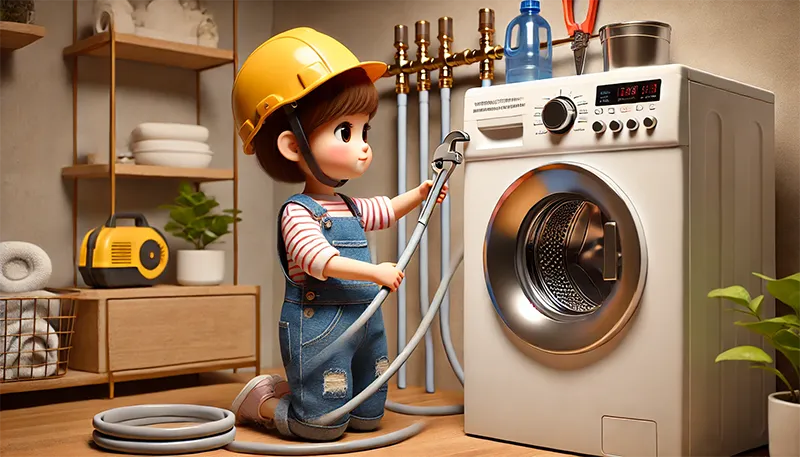Connecting a washing machine to your home’s water supply might sound complicated, but with the right steps, you can handle it yourself.
A secure and well-connected water supply ensures that your washing machine runs smoothly, free of leaks and issues, saving you time, money, and hassle.
Here’s a step-by-step guide connecting washing machine water supply like a pro.
Tools and Materials Needed
Before starting, gather the necessary tools and materials. Having these on hand will make the process smooth and efficient:
- Adjustable Wrench: Helps you tighten the hose connections without overtightening.
- Teflon Tape: Wrap this around the threads to ensure a leak-free seal.
- Pliers: Useful for any additional adjustments or for holding connections steady.
- Hose Clamps (if needed): For securing hoses if they need extra support.
These tools will help ensure each connection is secure and leak-free, preventing issues before they start.
Step 1: Turn Off the Water Supply
Start by turning off the main water supply to avoid accidental leaks or flooding.
- Locate Your Water Valves: In most homes, these are found near the washing machine area or in the basement.
- Turn Off the Valves: Twist each valve clockwise until it stops. This shuts off the flow of water, keeping you safe from any unexpected leaks while working.
Turning off the water is essential for safety and helps prevent potential water damage.
Step 2: Attach the Water Supply Hoses
Now it’s time to connect the hot and cold water hoses to the back of the washing machine.
- Connect Hoses to the Washing Machine: On the back of the machine, locate the inlet ports labeled for hot and cold water. Attach each hose to its corresponding port, being careful to match hot to hot and cold to cold.
- Hand-Tighten First: Begin by tightening the hoses by hand, then give them a slight twist with the adjustable wrench if needed.
- Use Teflon Tape: Wrap a bit of Teflon tape around the threads before attaching the hoses. This provides an added seal and reduces the risk of leaks.
Taking time to correctly attach the hoses will save you from leaks down the road and ensure proper water flow during each wash.
Step 3: Connect Hoses to the Water Faucets
Next, connect the opposite ends of the hoses to the home’s water supply faucets.
- Ensure Proper Placement: Make sure each hose is connected to its matching faucet, hot to hot and cold to cold.
- Tighten Connections Carefully: Use your adjustable wrench to secure the hoses, but avoid overtightening, as this could strip the threads or damage the faucet connection.
- Double-Check the Fit: Ensuring a snug fit is essential for preventing drips. If you spot any water seepage, give the connection another slight twist.
A well-connected hose at each faucet ensures consistent water flow, preventing the risk of leaks or flooding.
Step 4: Check for Leaks
Before finishing, it’s crucial to inspect for any leaks at the connections.
- Slowly Turn on the Water Supply: Open the water valves by turning them counterclockwise, allowing water to flow into the hoses.
- Watch for Drips: Carefully check each connection point. If you notice any drips, tighten the connection slightly until the dripping stops.
- Run a Short Cycle: Once all connections are dry, run a quick cycle on the washing machine to observe how it handles the water flow. Check for any issues with drainage or water pressure.
Taking this final step to check for leaks ensures that your installation is successful and your washing machine is ready to use safely.
FAQs
-
What happens if I connect the hot and cold hoses incorrectly?
Connecting hoses to the wrong inlets can affect your machine’s temperature settings and wash performance. Always double-check that hot goes to hot and cold to cold.
-
Can I use regular pliers to connect the hoses?
While adjustable wrenches are ideal, pliers can work in a pinch. Just avoid overtightening with either tool to prevent damage to the fittings.
-
How often should I check the hose connections for leaks?
It’s a good idea to check for leaks a few days after installation and then inspect them every six months to ensure everything is still secure.
-
Do I need to use Teflon tape on every connection?
Teflon tape is recommended for any threaded connections, as it helps prevent leaks by creating a watertight seal.
-
What should I do if I don’t have a dedicated hot water line?
You can still connect the cold water line, but be aware this may limit certain wash settings. Some machines can adjust based on a single cold water line, but consult your manual for details.
By following these steps, you’ll have your washing machine securely connected to your home’s water supply, ready to handle all your laundry needs.
Taking the time to check each connection and watch for leaks ensures a long-lasting, leak-free installation.
Enjoy peace of mind knowing your washing machine is set up correctly and ready for smooth operation!



